Mathematical Art
The following pictures were drawn by M.C. Escher, an artist celebrated
by mathematicians because of his ability to incoropate mathematical ideas
and concepts into his work (whether he realized it or not is an entirely
different matter). Some of the themes depicted in these images include
relativity, reflection, rotation, paradox, symmetry, perspective, angles, spheres
and other geometric figures, self-reference,
topology, chaos, tessellations, dimension, and the relationship of the part to the whole.

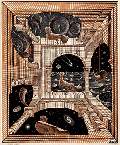
Another World
A room with a dizzying view; three perspectives
viewed simultaneously create a sense of alienness.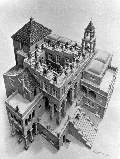
Ascending and Descending
A paradox; monks always walking up or down yet
never really getting anywhere.
Belvedere
Each half of the picture is realizable, yet the halves
taken together introduce an architectural paradox.
Day and Night
An illustation of symmetry and complements;
indistinguishable figure and ground.
Three Spheres
Yet, if you examine closely enough, you will
notice there are no spheres in this picture.
Hand with Reflecting Sphere
Projections onto a sphere; a view which neccessitates
that the artist be in the center of his world.
Drawing Hands
A self-referential drawing.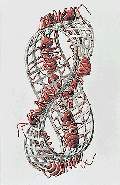
Mobius Strip II
Even though one ant may see another beneath her,
they both are on the same side of the strip.
Order and Chaos
Contrast between the states of order and chaos.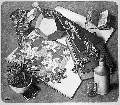
Reptiles
Interplay between two and three dimensions. It is also
illustrative display of a tesselation of the plane.
A "Repeated Tiling" of sorts. Appropriate, isn't it?
Three Spheres
But when reflections, light, and shadow are taken
into consideration, how many spheres are there?
Three Worlds
Three distinct yet inseperable pictures in one.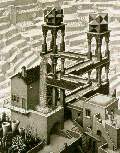
Waterfall
An architectual paradox many times over as well as
gravitationally impossible. Though the whole is a
paradox, portions of this scene may be realized.
Return to Mathematrix


Another World
A room with a dizzying view; three perspectivesviewed simultaneously create a sense of alienness.

Ascending and Descending
A paradox; monks always walking up or down yetnever really getting anywhere.

Belvedere
Each half of the picture is realizable, yet the halvestaken together introduce an architectural paradox.

Day and Night
An illustation of symmetry and complements;indistinguishable figure and ground.

Three Spheres
Yet, if you examine closely enough, you willnotice there are no spheres in this picture.

Hand with Reflecting Sphere
Projections onto a sphere; a view which neccessitatesthat the artist be in the center of his world.

Drawing Hands
A self-referential drawing.
Mobius Strip II
Even though one ant may see another beneath her,they both are on the same side of the strip.

Order and Chaos
Contrast between the states of order and chaos.
Reptiles
Interplay between two and three dimensions. It is alsoillustrative display of a tesselation of the plane.
A "Repeated Tiling" of sorts. Appropriate, isn't it?

Three Spheres
But when reflections, light, and shadow are takeninto consideration, how many spheres are there?

Three Worlds
Three distinct yet inseperable pictures in one.
Waterfall
An architectual paradox many times over as well asgravitationally impossible. Though the whole is a
paradox, portions of this scene may be realized.